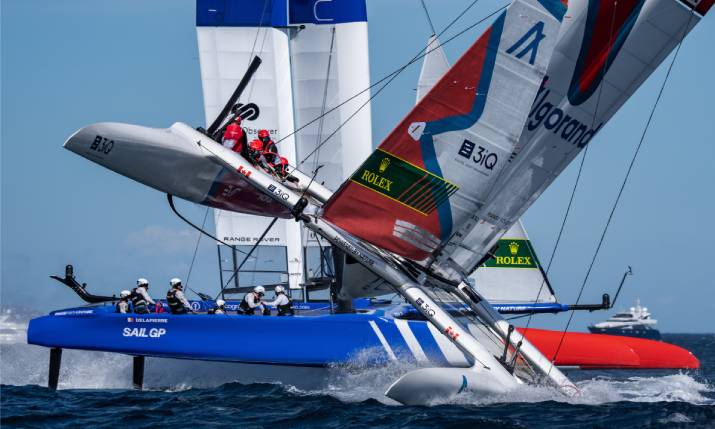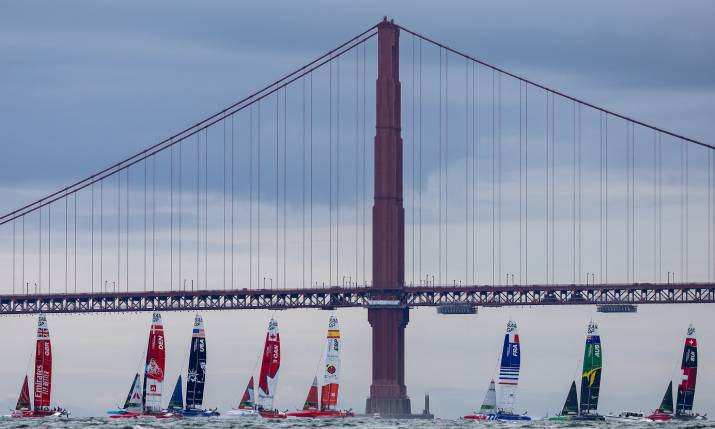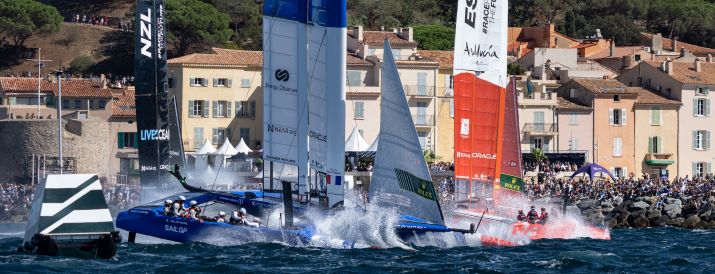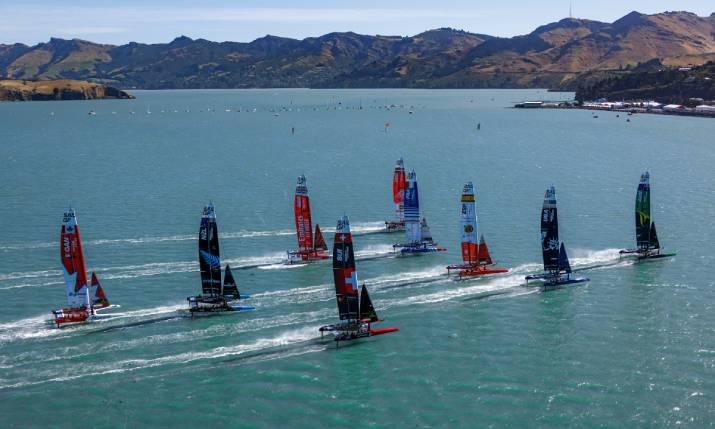Plain sailing: Behind the scenes on SailGP’s communications and audio

Timeline TV is the remote production partner for SailGP while Riedel provides the set up and infrastructure for the local part of the production onsite
SailGP is the fastest, most exciting, wettest, most punishing sailing competition on the planet, where nine teams pushing themselves to the limit on identical, state-of-the-art foiling catamarans.
Remotely produced tens of thousands of kilometres from the action, reliable connectivity is vital, not just for the broadcast but for the safety of the athletes on board. And all that while being sprayed by saltwater at 100 kilometres per hour and the constant risk of capsizing. If all that floats your boat, then read on.
SailGP has been making a splash since it first dropped anchor in Sydney in 2019. The annual competition is unique in both structure and ethos, with as much of a focus on the environment and local impact as on the actual racing.
This emphasis on sustainability washes into every aspect of the competition, meaning every supplier for the series is on board. It also means it has been remotely produced since the it began; wherever it is hosted, every event is produced by SailGP Productions at Timeline TV in London and delivered to over 200 international territories.
While Timeline is the remote production partner, Riedel provides the set up and infrastructure for the local part of the production onsite, working hand in hand with Timeline to provide a presentation that viewers would never guess was remote.
The event comprises of nine identical F50 catamarans at the race venue and a director in London with access to a wealth of data and multiple video sources, including 18 boat-mounted cameras, up to two helicopters, a drone, up to three chase boats and up to four RF cameras on shore. During season two, Oracle delivered 40 billion data points to the Oracle cloud during each day of racing, and 30,000 data points are processed every second from each F50 race yacht.

SailGP competitors race to the San Francisco finish line for Season 3 early in May 2023
Totally wireless
Every location camera is wireless. Riedel provides all the cameras on the race yachts and a complex RF network designed not only for every camera but also for audio, telemetry, tracking data and comms. Every signal is handed over to Timeline, including control data channels to remotely operate the PTZ cameras on the boats.
The comms solution is a bespoke version of Riedel’s Bolero wireless intercom, fully saltwater-proof and working in combination with two-way radios and Riedel’s Artist intercom. There are Bolero antennas on every F50, support boat and helicopter, and they are all networked via Riedel’s RF system to guarantee reliable coverage for the athletes as well as for every camera in the air and on the boats. The system is networked with another artist intercom owned and operated by Timeline.
“At this level, where every athlete is pushing the limits of the equipment, capsizing at speed is always a possibility. If that happens, power is shut down to protect the onboard equipment, which also shuts the transmitter down, so our backup RF radios operate on an emergency power circuit to guarantee comms”
Meanwhile, Riedel’s MediorNet is used onsite as a routing and fibre network to connect every location, and is used to transmit and receive signals with the central ops container. Here, Riedel’s team of engineers monitor signal flow to and from Timeline. MediorNet also provides multi-view and signal processing.
The challenges are already considerable. The punishing environment, the proximity of the competitors, the complexity of guaranteeing RF performance on water, and the task of providing a stable perimeter in the middle of the sea amplifies them even more.
Although Season 3 reached its climax in San Francisco this month, with millions watching Australia lift the season trophy in a breathtaking sprint finish, getting there has not always been plain sailing.
Drowning in numbers
Tim Puschkeit is Riedel’s head of project management. He has been with the company since 2019 and having spent years as Riedel’s project manager on the America’s Cup, sailing is in his blood.
“We started working with SailGP at the beginning of Season 2, immediately following the America’s Cup,” says Puschkeit. “Riedel worked on that project or three years. Like in SailGP, we were dealing with world-class athletes who aren’t concerned about any technical issues around the broadcast or the race management system; their focus is on the race and for them those things are mission critical, which means our focus is on guaranteeing that quality of service.
“Riedel’s core business is communication, so when those teams joined SailGP, they wanted to use the same equipment that they were used to and that they trusted. That opened the door, and we were then able to ask aside from comms, what more could we provide?”
Riedel’s comms package for SailGP meets the requirements of every stakeholder, and those requirements are very clear; teams need guaranteed communications to each other on the race yacht, they also need to speak to the chase boats, and they need to do this on isolated networks, and all this content needs to be available for broadcast use.
Each F50 catamaran has a crew of six athletes (a strategist, driver, a wing trimmer, a flight controller and two grinders) and each catamaran uses a standalone package of six Bolero beltpacks (for the crew plus the chase boat), with an additional spare.
“As soon as the system is powered up, the team can contact each other,” says Puschkeit. “Each Bolero system is a standalone network with a customised battery powered aerial in a sealed media bay in the hull.
“For broadcast coverage we take signals from each beltpack, add two cameras and two ambient mics which are also on the F50, and embed them with the video feeds to get the signals to the shore. Each beltpack is isolated as a separate audio track to ensure lip-sync is maintained for interviews, and all this is picked up by the remote production team at Timeline in London.”
 Fully redundant
Fully redundant
In fact, comms share several redundant paths from the F50’s across multiple power networks. Each Bolero signal is transmitted across three different paths: it is embedded in the video, sent over a local RF network, and there is a backup RF connection in the event that a capsize knocks out all the other equipment.
Puschkeit says: “This mesh solution is another managed technology solution introduced by Riedel and customised for SailGP. On the top of each mast is a white dome called a masthead unit, which combines IP data, comms and video and transmits it over a transceiver with a very special antenna design, developed exclusively for the harsh environments and difficult RF fields of sailing.
“At this level, where every athlete is pushing the limits of the equipment, capsizing at speed is always a possibility. If that happens, power is shut down to protect the onboard equipment, which also shuts the transmitter down, so our backup RF radios operate on an emergency power circuit to guarantee comms.”
Two birds with one stone
The masthead is not the only customised equipment on board, and Puschkeit says kit is continuously developed throughout the season to improve not only the quality of the comms, but the quality of the broadcast. Protection against saltwater is vital, but wind noise is also significant, while every manoeuvre creates incredible levels of G Force and the constant threat of impact.
“Development is always in tandem with the environment,” says Puschkeit. “As requirements change, so does the kit. We started the season with Bolero S units, but now we use a custom SailGP solution with waterproof housings. We removed some of the buttons for people who don’t need them, we moved push to talk (PTT) buttons to headsets for people whose beltpacks were buried under lifejackets, we modified the buttons with silicone caps, and we replaced connectors with non-standard connectors which work in maritime environments.”
“It doesn’t feel like we are a service provider; it feels like we are a partner, and that goes for all the companies involved. Wherever we are, we have well established teams onsite and at Timeline, and all of us are dedicated to developing the technology to improve the final product”
Prior to Riedel joining the team, each crew used two wireless mics: one for comms and another for broadcast use. Although practical it did not look great for broadcast and there were issues with other teams being able to listen in. Riedel therefore developed a single mic system which covered both crew requirements and live broadcast coverage.
“It was a win-win for everyone as the crew have a vested interest to ensure the mics are in the optimum position for comms, which means they are also in the optimal position for television output,” adds Puschkeit. “But my favourite customisation is a feature we integrated into the boat’s onboard touch display which allows each beltpack user to customise the volume or threshold of their mic and earpiece individually. Being able to adjust how they interact with each other depending on the environment on the water leads to better communication and better television.”

SailGP teams need guaranteed communications to each other on the race yacht, to speak to the chase boats, and they need to do this on isolated networks, and all this content needs to be available for broadcast use
Congestion on the water
But there is another challenge which the teams have less control over, and it is a combination of maths and geography. A fully wireless production out at sea requires a huge amount of bandwidth; the production has a fleet of nine boats, each with powerful transmitters covering a minimum range of five kilometres. There are also three camera chase boats, a reporter boat, and up to two helicopters.
There are another four handheld cameras on the shore, up to 30,000 spectators connecting to local cell towers, seaplanes setting out on journeys, ferries coming into dock and areas on the water where people can join the event in their own boats. In Cadiz, Andalucía, Puschkeit also had the addition of military boats stationed in the port.
“It puts a huge strain on resources and not only on the RF spectrum. That amount of traffic pushes the noisefloor up considerably. Planning and preparation is vital, and Riedel is very adept at local licensing, but on the water the environment is less restricted and more unpredictable and we need to plan for spare and backup frequencies.
“We have 12 engineers on site at every event split into one team at the tech site and one at the TV compound. This means that if we lose local links, we can still produce TV output using a receiving infrastructure which is physically closer to the racecourse for audio, video and data from all assets on the water.
“As the season developed, we’ve also moved more people to our remote operations centre (ROC) in Wuppertal. A big part of SailGP is about sustainability, and we have worked hard to reduce our impact by reducing travel. All signal routing is done remotely through Riedel’s Mediornet from the ROC, and every F50 is checked and monitored from the ROC as part of the mooring checks when the boats are placed into the water.
“We talk each line through, and we can even tweak EQs on each beltpack to filter out certain frequencies to make everything clearer.”
Winning attitude
Like other top tier sports, SailGP demands perfection across all its comms, both to keep competitors safe and on top of their game, and to keep viewers enthralled. At this level, those requirements are transferable from other sports, but with SailGP there have been many additional challenges to overcome.
For Puschkeit it is a team effort, and the continuous development with both the sport and the broadcast crews helps deliver better service for everyone.
“It doesn’t feel like we are a service provider; it feels like we are a partner, and that goes for all the companies involved. Wherever we are, we have well established teams onsite and at Timeline, and all of us are dedicated to developing the technology to improve the final product.”
The SailGP Season 3 Grand Final was held in San Francisco on 6 to 7 May 2023. Season 4 begins in Chicago on 16 to 17 June
